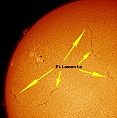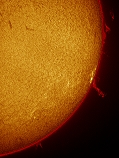
The sun's outermost "shell", the chromosphere, is a region measuring approximately 2000 km deep and is the source of some
incredibly dynamic activity and temperatures reaching 400,000 °C at its furthest distance from the photosphere
and is not visible to the naked eye or telescope filtered with typical mylar white-light material. Although the latter
provides interesting views of the solar disk and the various sunspots and sunspot groups (see
here) with some granulation during moments of good seeing, H-alpha
filters add a totally new dimension to our closest star as they permit for the observation and imaging of the glowing red
hydrogen gas which makes up nearly 80% of the sun. Violent explosions and outbursts involving the hydrogen gases and the
process of nuclear fusion of hydrogen to helium lead to the development of filaments, flares and prominences. For the
former, one will observe typically dark patches of red on the solar limb as a result of the trapped gases. In contrast,
flares and prominences represent ejected material which can reach distances of up to 2 million kilometers from the sun.
Filaments and prominences are typically characterized as Class I ("Quiescent Filaments and Prominences") or Class II
("Active Filaments and Prominences"). For the former, they can last for a few months and typically show little activity
from day-to-day. In contrast, the latter are much more dynamic and short-lived, may even last for only a few hours and
often produce, for example, very beautiful "flare loops" and "coronal rains".
 Filaments NE Quadrant 2003-06-04 |
 |
 |
 SW Quadrant 2003-06-01 |
 |
 |